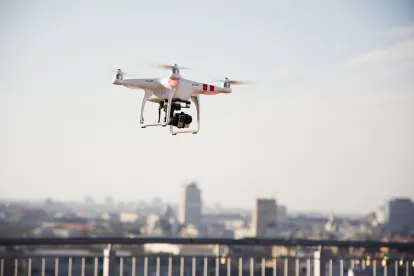Over recent years, the consumer and commercial market for drones has seen significant growth, and this growth will only continue. Credit Suisse predicts that the drone market will increase to $43 billion by 2024. While there are many social and economic benefits to drone use, there are also significant challenges, particularly with regard to jurisdiction, airspace property rights, and privacy.
Since their military origin as an alternative to manned military aircraft, drones (a.k.a., unmanned aerial systems (UASes) or unmanned aerial vehicles (UAVs)), have evolved and are now being utilized in a number of settings to capture high-quality images and videos, access remote areas, save money, and save lives. Beyond the weekend hobbyists, persons in retail, medicine, construction, urban planning, agriculture, meteorology, insurance, journalism, real estate, utilities, mining, clean energy, and cinematography use drones on a daily basis. Emergency responders, law enforcement officers, and humanitarian and disaster relief workers also utilize drones to protect and serve the public.
In the 20th century, laws and regulations regarding ownership of airspace above private property focused on the concept of nuisance and full enjoyment of the land. High altitude flights were permitted without regard to property owners, while low altitude flights, take-offs, and landings had to take into consideration the impact on property and property owners. The Supreme Court’s 1946 ruling in U.S. v. Causby, set an early standard for defining low altitude, airspace rights. In Causby, a North Carolina chicken farmer sued the federal government for conducting low altitude, bomber flights (as low as 83 feet) over his once prosperous chicken farm, causing distress to his chickens, a drop in egg production, and loss of Mr. Causby’s livelihood. The Court reasoned:
We have said that the airspace is a public highway. Yet it is obvious that if the landowner is to have full enjoyment of the land, he must have exclusive control of the immediate reaches of the enveloping atmosphere…The landowner owns at least as much of the space above the ground as he can occupy or use in connection with the land…We think that the landowner, as an incident to his ownership, has a claim to [the immediate reaches of the airspace] and that invasions of it are in the same category as invasions of the surface.
Responding to the growth of drone use in the private sector, Congress in 2012 charged the U.S. Department of Transportation (USDOT) and the Federal Aviation Administration (FAA) to devise a plan for the safe integration of commercial and recreational drones into the national airspace system. Yet, 75 years out from Causby, laws regarding drone jurisdiction, airspace property rights, and privacy remain in a state of flux, both because the federal government is still developing key aspects of its drone safety and security requirements and because there are limited court decisions to date addressing whether these requirements are consistent with statutory authorities. (9/16/2020 U.S. Government Accountability Office (GAO) report on drones and jurisdictional, property, and privacy legal issues).
In fact, drone proponents question whether Causby’s position on low altitude airspace property rights is even binding precedent. Drone proponents have taken the position that states are preempted from regulating/prohibiting drone operations at low altitudes, arguing that preemption is necessary to ensure the safety and efficiency of the national airspace system. They argue that preemption is necessary to avoid a patchwork of state laws that would hinder technological innovation. (9/16/2020 GAO report).
Drone proponents have taken the position that states are preempted from regulating/prohibiting drone operations at low altitudes, arguing that preemption is necessary to ensure the safety and efficiency of the national airspace system.
Complicating matters further is the FAA’s position on the scope of its regulation of airspace. In its statement, “Busting Myths about the FAA and Unmanned Aircraft – Update”, the FAA asserts that it “is responsible for air safety from the ground up.” While it has set not set a minimum flight altitude for drones, the FAA has set a maximum flight altitude of 400 feet, placing drones in relatively close proximity to people and structures on the ground. (9/16/2020 GAO report).
In its 9/16/2020 report, the GAO identified the following as key, unresolved drone jurisdiction and privacy issues:
Whether Congress may use its power under the U.S. Constitution’s Commerce Clause to regulate all drone operations, including non-commercial, non-interstate, low-altitude operations over private property, and if so, whether Congress has authorized FAA to regulate all such operations;
What impact possible Fifth Amendment-protected property rights held by landowners in the airspace within the “immediate reaches” above their property may have on federal, state, local, and tribal authority over low-altitude drone operations;
Whether and to what extent Congress intended to preempt states, localities, and tribes from regulating drone operations at low altitudes;
What liability drone operators and the federal, state, local, and tribal governments may have to landowners under state aerial trespass and constitutional takings law precedents for conducting, regulating, or preempting state regulation of drone operations in low-altitude airspace, and whether landowners may exclude drones from their overlying airspace; and
Whether existing federal and state privacy laws adequately protect against invasions of physical privacy and personal data privacy involving drone operations and what authority the federal, state, local, and tribal governments have to enact additional measures that may be needed.
In sum, the legal and regulatory landscape for the operation of commercial and recreational drones is far from settled. Drone manufacturers and other stakeholders, including retailers of consumer products, foods, and healthcare products, need to monitor court decisions and the patchwork of laws and regulations at the local, state, and federal levels.




 />i
/>i

